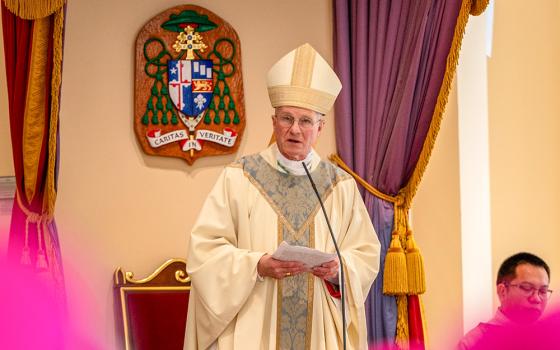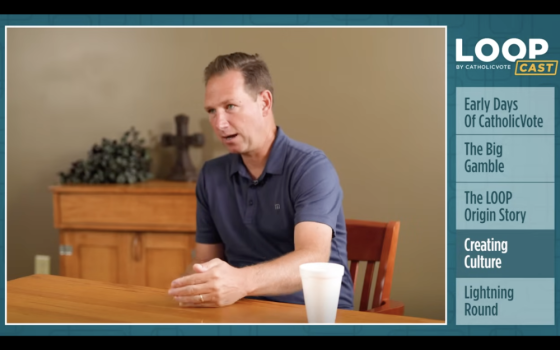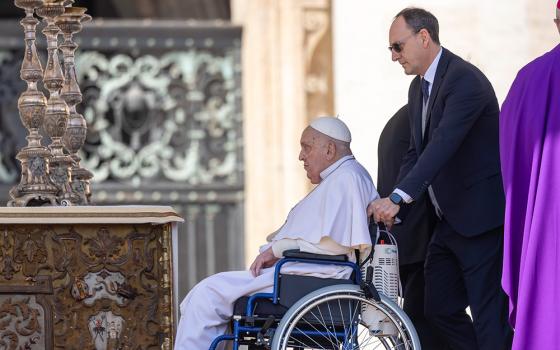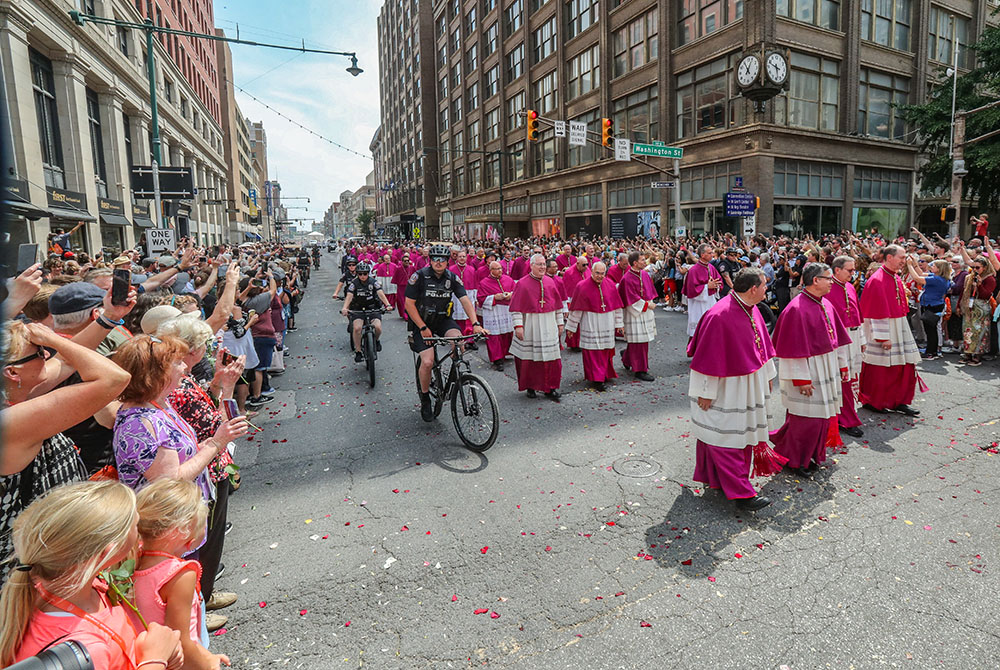
Bishops join the final eucharistic procession of the National Eucharistic Congress in downtown Indianapolis July 20. (OSV News/Bob Roller)
Many Catholics were hasty to assume that the opening ceremony of the Olympics went out of its way to "mock" the Last Supper. The instant outrage the tableau aroused — right or wrong — tells a larger story about something that has happened in Catholic life across the last four decades. But it has not been the only recent indicator.
In a January report on religious liberty the U.S. bishops told us somewhat alarmingly of their concern that "the very lives of people of faith" are threatened in the United States. Cardinal Timothy Dolan inveighed in June against New York's proposed Nonpublic Dignity for All Students Act with complaints about "bullying" Catholics and forcing Catholics to "toe the line on "gender ideology." One of the first attacks leveled at Kamala Harris once she became the presumptive Democratic nominee for president was that she "hates what [Catholics] believe."
We Catholics have come to prize a little too much being outsiders set against the culture and the world. Quite often, Catholics seem crouched defensively as though the church were under constant attack.
That's not a coincidence. For several decades, Catholics in the U.S. have been taught to see the world as a hostile place set against us, and to think of ourselves as a "sign of contradiction" set against that world.
This point of view has been nurtured within the church for two generations. Forty years can make it seem like Catholics always have seen our relationship with the world this way. We have not. And, in fact, that idea does not reflect our tradition very well.
A temptation to stand apart from the world has always dogged the church. The last 40 years have seen Catholics succumb thoroughly to that temptation, desiring to be a 'sign of contradiction.'
No matter how the 1962-65 Second Vatican Council called the church to turn toward and embrace the world — indeed, no matter how St. Augustine reminded us that our faith "does not repeal or abolish" the laws and norms of the world in which we make our earthly pilgrimage — we Catholics insist more and more on what historian Leslie Woodcock Tentler has called "Catholic difference." We have come to be intoxicated by being different, standing apart, and the idea that the world is out to get Catholics.
It was not always this way. Vatican II itself proved that while the world is not the same as the church, the church can and must see the world as a partner. The world is the field of salvation given to the church (Matthew 13:38).
A temptation to stand apart from the world has always dogged the church. The last 40 years have seen Catholics succumb thoroughly to that temptation, desiring to be a "sign of contradiction."
That phrasing — "sign of contradiction" — deserves particular attention. We find it in the Gospel of Luke (2:34) and in the Acts of the Apostles (28:22). But the phrase came into its recent popularity during the John Paul II papacy. He used the phrase as early as a 1979 Angelus message, three months after his election. But Pope John Paul began to speak of Catholics as a sign of contradiction to the world with considerable frequency after 1987.
A quick search of the Vatican website discloses 45 uses of the phrase "sign of contradiction" during the John Paul II papacy, 39 of which came in 1987 or later. The Seventh General Assembly of the Synod of Bishops which took place in October 1987 may well have been the turning point that gave so much life to that oppositional, "sign of contradiction" narrative that we live with even today.
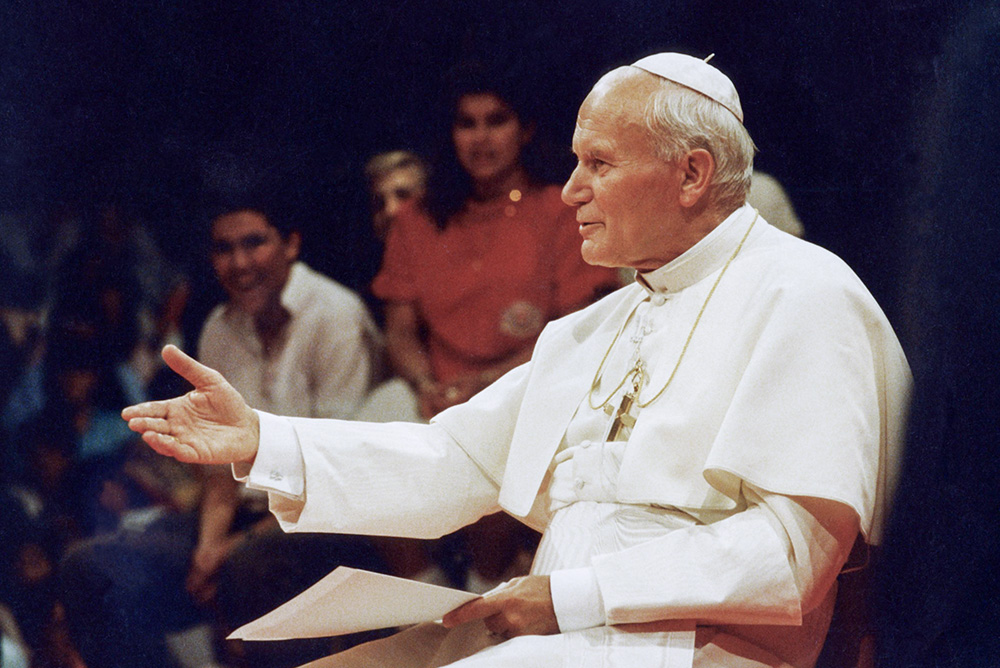
Pope John Paul II answers questions from young people in Los Angeles Sept. 15, 1987, during a teleconference broadcast to several locations in the United States. (CNS/Joe Rimkus Jr.)
Addressing "the vocation and mission of the lay faithful in the church and the world," the synod took up the most neuralgic questions that had dogged the church since Vatican II. They included the role of women and the participation of laypeople more generally in church leadership.
In 1987, NCR described that synod as the "first clear test of strength between papal loyalists and post-Vatican II church leaders" — we might say, between those who preferred to restrain the council's reforms and those who intended to press them forward.
Looking back, it seems clear that those who preferred to restrain the council prevailed, and something shifted in the church after the 1987 synod. The influence of leaders like Milwaukee's Archbishop Rembert Weakland and Chicago's Cardinal Joseph Bernardin waned. Others like Boston's Cardinal Bernard Law and New York's Cardinal John O'Connor ascended, and the overall trajectory of the U.S. bishops has traced the path of their influence since 1987.
It seems inescapable that under Pope John Paul the church began to embrace its identity as a "sign of contradiction," a church in opposition to the world.
We'd want to say that this turn is more complex than a choice to change direction. It was in understandable ways, entirely natural. Pope John Paul II's biographer, George Weigel, has written about the life experience of the Polish-born pope, how in the struggle with Nazism and Stalinism he grew up with "it was always 'we' and 'they,' 'us' and 'them.' ... Somebody was going to win and somebody was going to lose."
John Paul's influence and legacy have been captured by people like Weigel who certainly are comfortable with being a "sign of contradiction." But also, the facts of John Paul's life gave them a lot to work with. John Paul II's long papacy drew from his personal experience of " 'us' and 'them' " and helped fix a "sign of contradiction" narrative in the Catholic consciousness.
Advertisement
Thinking this way for decades has effects. One of them I've mentioned is that it can become difficult to remember that it ever was another way. Forty years is a long time. But there is another insidious effect we should note.
The "sign of contradiction" narrative carries an implicit criticism of the modern world where the church does not hold any special stature or power. Few believers in the Christendom of the Middle Ages had reason to see the world as an adversary. For Catholics to see the world as an adversary depends on the separation of church and state, religious freedom, and all that we take for granted in a modern constitutional republic.
That criticism of the modern world embedded in the "sign of contradiction" narrative inevitably has favored those who would restrain Vatican II, those who would resist the modern world. And this has had vast consequences.
Thinking of ourselves as a "sign of contradiction" for so long has driven the Catholic Church out of the cultural mainstream and, doing so, fueled the disaffiliation of Catholics from the church. When Ryan Burge commented for NCR in June that "If you're a white person and religious, you're almost Republican by default," he was testifying to a larger trend — the crisis of disaffiliation that others have described as a "big sort."
The problem is bigger than the Catholic Church and it might well have impacted the church in any event. But certainly it is true that we Catholics have helped sort ourselves out of the world by facing the world with a "sign of contradiction" for so long.
Inevitably this has consequences for the effectiveness of our witness, our ministries and our mission.
Another synod will have its second session in a few months. It will, in part, address some of those issues left unresolved since the 1987 synod. Perhaps this time, the call to become a synodal church can help Catholics cease to contradict the world with such determination and rediscover how to walk together with it.

